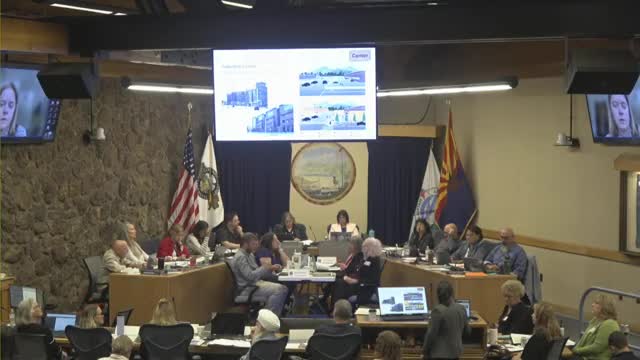Planned trails on private land prompt policy shift: officials favor flagged private‑land markers over exact lines
May 03, 2025 | Flagstaff City, Coconino County, Arizona
This article was created by AI summarizing key points discussed. AI makes mistakes, so for full details and context, please refer to the video of the full meeting. Please report any errors so we can fix them. Report an error »

A central debate at Friday’s joint regional plan retreat concerned how the Flagstaff Regional Plan should show planned trails that cross private property.
At issue: the draft plan uses dashed lines to show “planned and proposed” trails. Several private‑land owners and the City’s legal and parks staff raised concerns that showing dashed lines on a public digital map can drive recreational trespass and create safety and fire risk on private property. “We just had a fire that came up. Fortunately it was snuffed out early, but it could have been a significant tragedy,” said a private‑land representative in public comment.
Public and official reactions
Developers and private owners urged the map to avoid an impression that the dashed line equals a legal public trail. Little America and other large parcel owners told officials dashed lines had encouraged social‑media‑driven trespass.
Most elected and appointed officials at the retreat preferred a middle ground: keep the plan’s trail intent visible but change the symbology or add clear disclaimers for private parcels rather than showing a final line. Several speakers suggested use of a distinct color or marking for planned trails on private land along with a map legend stating clearly: “Planned trail shown does not constitute legal public access unless a legal trail easement is recorded.”
Staff view and next steps
Staff described two options for responding to comments: (1) maintain the dashed‑line approach with an expanded disclaimer in the plan and online map; or (2) change to a less‑specific symbology (for example, arrows or a unique color) for planned trails that are located on private parcels where no easement exists.
After an on‑the‑spot vote among elected and appointed officials, a clear majority favored a private‑land distinction (the retreat’s “Sweet‑Mandino” compromise): show trail intent while using a distinct visual treatment and strong legal disclaimers for non‑easement routes. Staff said they will now draft revised map symbology and stronger legend language and circulate it for review.
Ending: The joint body asked staff to return the map with a clearer visual treatment for non‑easement trail corridors and with recommended language the city and county can use on the public web map to discourage trespass and explain legal status.
At issue: the draft plan uses dashed lines to show “planned and proposed” trails. Several private‑land owners and the City’s legal and parks staff raised concerns that showing dashed lines on a public digital map can drive recreational trespass and create safety and fire risk on private property. “We just had a fire that came up. Fortunately it was snuffed out early, but it could have been a significant tragedy,” said a private‑land representative in public comment.
Public and official reactions
Developers and private owners urged the map to avoid an impression that the dashed line equals a legal public trail. Little America and other large parcel owners told officials dashed lines had encouraged social‑media‑driven trespass.
Most elected and appointed officials at the retreat preferred a middle ground: keep the plan’s trail intent visible but change the symbology or add clear disclaimers for private parcels rather than showing a final line. Several speakers suggested use of a distinct color or marking for planned trails on private land along with a map legend stating clearly: “Planned trail shown does not constitute legal public access unless a legal trail easement is recorded.”
Staff view and next steps
Staff described two options for responding to comments: (1) maintain the dashed‑line approach with an expanded disclaimer in the plan and online map; or (2) change to a less‑specific symbology (for example, arrows or a unique color) for planned trails that are located on private parcels where no easement exists.
After an on‑the‑spot vote among elected and appointed officials, a clear majority favored a private‑land distinction (the retreat’s “Sweet‑Mandino” compromise): show trail intent while using a distinct visual treatment and strong legal disclaimers for non‑easement routes. Staff said they will now draft revised map symbology and stronger legend language and circulate it for review.
Ending: The joint body asked staff to return the map with a clearer visual treatment for non‑easement trail corridors and with recommended language the city and county can use on the public web map to discourage trespass and explain legal status.
View full meeting
This article is based on a recent meeting—watch the full video and explore the complete transcript for deeper insights into the discussion.
View full meeting
